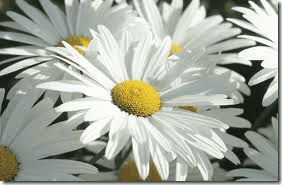The Shasta daisy is an easy-to-grow perennial plant that bears cheerful blooms with white petals and deep yellow centers that are recognizable to all. The Shasta daisy is a perennial plant hardy in U.S. Department of Agriculture plant hardiness zones 4 through 9. This reliable bloomer provides color and interest in home landscapes. Successful blooming depends on knowing when to plant the Shasta daisy plants and how to provide the right conditions for healthy growth.
Shasta Daisy Requirements
-
Shasta daisy plants require full sun and well-draining soil. They do not tolerate wet soils or soil that remains wet in winter. Deadheading, which is removing old blooms from the plant, encourages new flowers to provide blooms throughout the summer and into the fall. Shasta daisies require little additional maintenance beyond simple weeding and periodic applications of fertilizer. Shasta daisies attract butterflies to your yard. They make good cut flowers and work well as dried flowers for arrangements.
Planting Shasta Daisy Plants
-
Prepare a bed for the plants by digging at least 6 inches deep, pulverizing the soil carefully and removing wood, rocks and other debris from the area. Work in compost or processed manure to provide organic matter for soil aeration and water retention for the new plants. Perennial plants benefit from raising the soil bed 4 inches to avoid poor drainage and "wet feet" on plants. Work into the soil about 2 lbs. of 5-10-10 fertilizer for every 100 square feet of area before planting.
Best Times To Plant
-
Perennial Shasta daisies are generally planted in the spring, but you can also sow Shasta daisy seeds in the fall, allowing them to winter over to regrow in the spring. Space the Shasta daisy plants 1 to 2 feet apart, depending on type at maturity. When transplanting seedlings, set plants level with the soil surface. Fill in the soil and tamp it down. Water generously to encourage new roots. A layer of mulch holds down weed growth and keeps roots cool during hot weather.
Shasta Daisy Care
-
Provide additional water during dry periods. Shasta daisies may produce fewer flowers in extreme heat. Add compost to the soil in the spring to aid water retention. Cut back the tops of flowers after the first frost and spread a layer of peat moss to protect the perennial roots over the winter. Divide plants in the fall when they begin to get too crowded. Apply a slow-release balanced fertilizer for the growing season.


Deprecated: strpos(): Passing null to parameter #1 ($haystack) of type string is deprecated in /home/agriviek8Qv/agriviet.net/public_html/wp-includes/comment-template.php on line 2522